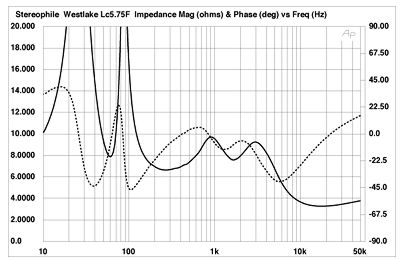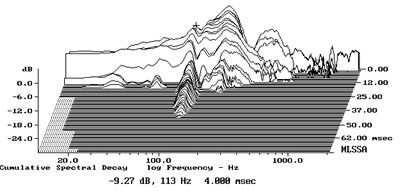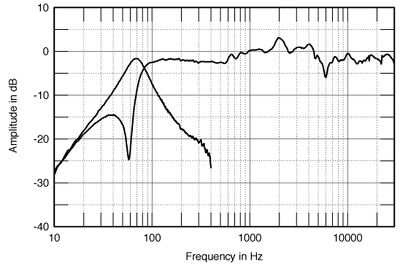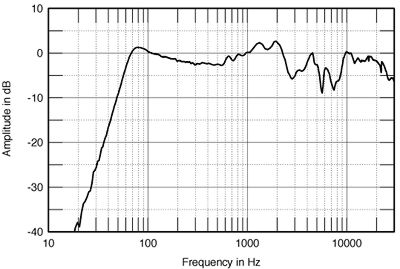| Columns Retired Columns & Blogs |
Westlake Audio Lc5.75F loudspeaker Measurements
Sidebar 3: Measurements
The little Westlake Audio Lc5.75F was of slightly-below-average sensitivity, at an estimated 84dB(B)/2.83V/m. However, its impedance magnitude (fig.1, solid trace) stayed above 6.8 ohms throughout the bass, midrange, and low-treble regions, and even when the electrical phase angle is large—as it is between 90Hz and 120Hz—the high magnitude in the same region ameliorates any problems with drive difficulty. Only in the top octave, where the impedance drops below 4 ohms, will the speaker demand more than an 8 ohm-rated amplifier—and perhaps not even then, given the lack of music energy in this region with most types of music. The saddle centered on 60Hz in the magnitude trace indicates the tuning of the small port, which in turn implies only modest bass extension.

Fig.1 Westlake Lc5.75F, electrical impedance (solid) and phase (dashed). (2 ohms/vertical div.)
There are no wrinkles in the impedance traces that would indicate the presence of panel resonances, and indeed, exploring the small cabinet's vibrational behavior with a simple plastic-tape accelerometer revealed that it appeared to be relatively well-braced. However, the walls did appear to flex a little in the upper bass, as revealed by fig.2, a cumulative spectral-decay plot calculated from the output of the accelerometer fastened to the back wall beneath the terminals.

Fig.2 Westlake Lc5.75F, cumulative spectral-decay plot of accelerometer output fastened to back panel beneath terminals. (MLS driving voltage to speaker, 7.55V; measurement bandwidth, 2kHz.)
Due to logistical problems, I had not read Michael's review text before I measured the Lc5.75F, so I chose my usual tweeter axis for the main set of response measurements. (I use DRA Labs' MLSSA system with calibrated B&K and Mitey Mike II microphones to perform my acoustic measurements of loudspeakers.) The Westlake's farfield, quasi-anechoic response on its tweeter axis, averaged across a 30 degrees horizontal window, is shown in the right half of fig.3. The on-axis output slowly rises through the midrange, and peaks by 2dB in the presence region. The transition to the tweeter looks a bit ragged, with the tweeter passband then flat, if shelved down by a couple of dB.

Fig.3 Westlake Lc5.75F, anechoic response on tweeter axis at 50", averaged across 30 degrees horizontal window and corrected for microphone response, with the nearfield woofer and port responses plotted below 400Hz.
Also shown in fig.3 are the nearfield responses of the woofer and port. The latter is the narrow bandpass peaking in the region between 50Hz and 70Hz and dropping at 12dB/octave above and below that region. Its midrange output is free from resonant modes. The woofer response drops to a sharply defined notch at the port tuning frequency of 60Hz. In the left side of fig.4 is shown the combined output, summed in the ratio of their radiating diameters and taking acoustic phase into account. While this complex sum of the two individual outputs appears to peak slightly in the upper bass, this will be mainly due to the assumption of a 2pi environment inherent in the nearfield measurement; it is probable that the Lc5.75F would actually be maximally flat in an anechoic chamber.

Fig.4 Westlake Lc5.75F, anechoic response 5 degrees below tweeter axis at 50", corrected for microphone response, with the complex sum of the nearfield woofer and port responses plotted below 300Hz.
- Log in or register to post comments




































